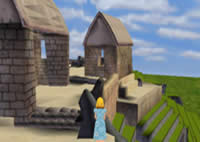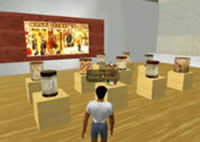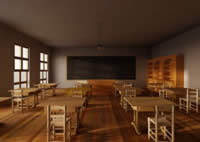© 2008 Ulrich Rauch, Tim Wang, Marvin Cohodas, and Negin Mirriahi.
The text of this article is licensed under the Creative Commons Attribution-Noncommercial-Share Alike 3.0 License (http://creativecommons.org/licenses/by-nc-sa/3.0/).
EDUCAUSE Review, vol. 43, no. 5 (September/October 2008)
Arts Metaverse

Have you always wanted to travel across your country or the world to tour an archaeological excavation site but never had the opportunity to do so? Have you dreamed about venturing into the past and seeing an ancient site as it stood centuries ago? Have you wanted to be able to sit in a virtual café, talk with a colleague, browse a web page, and view a video clip, all in the same virtual environment? Then step into the Arts Metaverse (http://artsmetaverse.arts.ubc.ca/), a 3D virtual learning environment (3D VLE), and visit places that you thought were impossible, or maybe just inconvenient, to reach.
Purpose and Goals of the Project

For years, students have learned about faraway places or ancient cultures from books, images, and videos. They have had to imagine how it would feel to be in a particular city, country, or community. Taking a class field-trip to distant places has been a dream for many teachers and students—for centuries. The Arts Metaverse strives to provide students with the authentic and meaningful learning experience of visiting virtual and digital 3D buildings, communities, and cultures without leaving their home or school. Wandering and virtually exploring an environment while digitally interacting with peers or teachers should help students achieve a better sense and understanding of the architecture, culture, or society they are virtually exploring and studying. Students walk on streets they never could before and go inside buildings that they could only dream of visiting. The ability to collaboratively explore a 3D virtual learning space increases students’ interest and curiosity in a particular subject area, leading to a more engaged and effective academic discourse and resulting in a richer learning experience.
About the Platform

The Arts Metaverse was developed by the University of British Columbia’s Arts Instructional Support and Information Technology unit. It is an immersive 3D VLE that provides an opportunity for scholars, teachers, students, and interested individuals to create and share a virtual space in collaboration. The Arts Metaverse enables high-quality, scholarly, and academically accurate 3D content creation for teaching and research purposes. Through the process of mapping, sketching, data-collecting, and subsequent modeling, scholars achieve a better understanding of the research subject or learning objective. In a next step, this new content is distributed widely through the 3D VLE to learners as well as to other researchers or the community at large. Scholarly responses for each project are collected, archived, and processed to improve the knowledge base of the subject matter. The Arts Metaverse is based on the open-source Croquet platform (http://www.opencroquet.org/index.php/Main_Page). It runs identically on Windows, Mac, and Linux operating systems. This platform allows users to integrate high-end graphics with sound, simulations, collaborative technologies, and social networking tools, enhancing virtual interactions and communication with each other.
